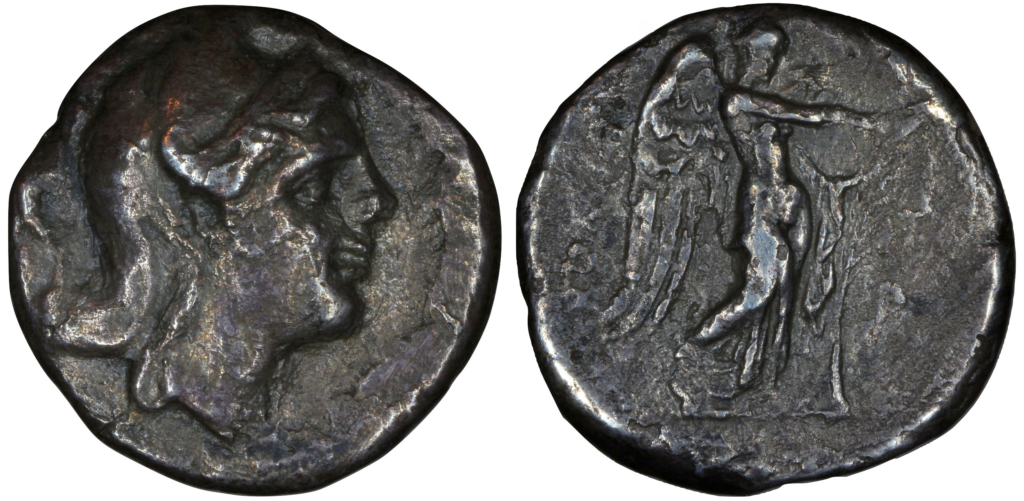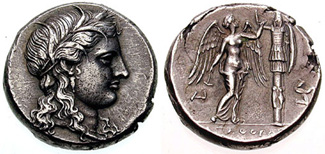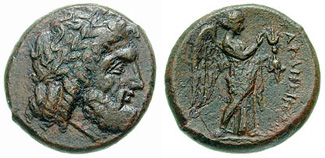
There are many candidates for the most beautiful Roman Republican coin, but for me, any shortlist would have to include this piece. I want, however, to think about the reverse in particular.
Naked to the waist a winged female is attaching a wreath to a palm branch. The wreath and palm are emblematic of victory as such objects were awarded to winners, and so the winged female can be none other than Victoria, the goddess-personification of victory. Her drapery is slung over her left arm and slips down at her right thigh, exposing her naked body to the viewer; her turn is coy and, by turning and placing her arm across her body, she emphasises that there is something to look at (compare the Venus of Cnidus or the Crouching Venus types).
Victoria’s torso is delineated in softly modelled curves, which with astonishing economy of detail communicate a smooth and beautiful female form. Her wings are very large: her right wing is decorated with individual feathers and long graceful primaries, while her left is visible only at the bend, creating a powerful sense of depth. Victoria’s pose is a seductively powerful and exaggerated contrapposto, with hip shot left, and her right Spielbein delicately rested on the groundline.
In an earlier coin, a silver tetradrachm issued in Syracuse by Agathocles, we see a similar composition. Victoria is again gracefully engaged in an appropriate activity, this time finishing the decoration on a tropaion, and she has similar falling drapery.

www.cngcoins.com
In another coin intermediary in time between the Republican didrachm and the tetradrachm, an obol from Tarentum, we see a standing Victoria holding a thunderbolt, but her wing is in the same bold composition. A comparison between these three is instructive for emphasising the artistry of the Republican example. While the didrachm owes something to its iconographic predecessors, it clearly goes beyond them.

www.cngcoins.com
Firstly, the didrachm artist has chosen to depict Victoria languidly tying the wreath to the palm in a posture that suggests her confidence and relaxation (and thus the security of Roman victory) and also shows her physical form in an alluring manner. By contrast the Victoria of the tetradrachm is depicted at the point of stretching above her chest – reflexively, her wings are unfurling to help her hover. It is a lively scene, but not one which relishes the physical form as the didrachm does; her nudity is not concealed and therefore does not seem like it needs to be concealed. She is posed in an engaging, almost three-quarter posture, but lacks the torsion of the didrachm. Her contrapposto is so slight it has barely affected her hips at all.
The bronze obol, on the other hand, presents a Victoria who appears to be toying with the lightning. That is a pretty powerful statement about Tarentine victories – but she seems a little pensive, and holds the lightning in a manner which suggests that it is a novelty to her. The coin artist has depicted her also in a much more modestly draped manner. For all these reasons, I think the didrachm image is a masterpiece which acknowledges but develops its models.
One question which might occur to a modern viewer is “why is Victory eroticised?” There is no simple answer, but it is a theme which is riven through Roman art. An eroticised Victoria implies that it is proper for the Roman viewer to lust after victory; the metaphorical conjunctions between physical and erotic conquest are of course manifest. The goddess on this didrachm, who lolls siegessicher and beautiful, is a powerful exhortation to the viewers to recall and embrace Rome’s martial destiny.
Bellinger, A. R. and Belincourt, M. A. (1962) “Victory as a Coin Type”, Numismatic Notes and Monographs, 149, 1-68.
Burnett, A.M. and Burnett, A. (1986) “The Iconography of Roman Coin Types in the Third Century BC”, Numismatic Chronicle, 146, 67-75.